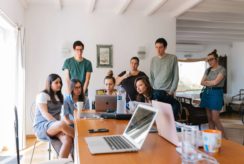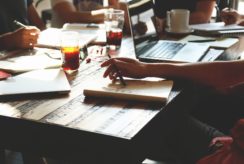Triggered in March, the first French quarantine created considerable disruptions in the ways of working. For many companies, remote working, which was before seen as the exception, became the norm. Being autonomous in organizing your own workday from home or managing your team without seeing its members changed the way work is perceived. Let’s also mention the relationships between an employee and his/ her company, the quality of life at work, or the use of tools: many aspects of the employee experience evolved with the health crisis.
If remote working did not wait for the health crisis to appear, it certainly gave the impulse to increase the technological, societal and economical evolutions already in place. It became a real necessity to have a position to put in place a concrete image of the ‘employee of tomorrow’, and the different possible scenarios, greatly depending on the maturity of organizations on the topic before the crisis.
The health crisis and quarantine: reinforcement of already existing changes
Technological pressure: the most distinct evolution in favor of new ways of working
As stated in the article The future of work, Is the office finished from The Economist, the PDF electronic document came out nearly 30 years ago. Collaborative tools, such as Slack (created in 2009), Zoom (created in 2011) strengthened this technological revolution: over the last ten years, most of the activities became achievable remotely. According to the British newspaper, it is ‘the natural inertia which allowed offices to escape from real disruption’ and made them resist to this technological pressure. With the health crisis, technological pressure became extremely strong and allowed those natural inertia tools achieve a decisive win: 63% of workers became remote workers for the first time with the first quarantine. [1]
Economical pressure: the second evolution the health crisis strengthened
With economical concentration in the large cities, real estate costs are constantly rising and become an additional charge in the company’s accounts. This real estate cost echoes the cost of work: salary must be high enough to allow employees to find an accommodation.
Therefore, the rise of real estate contributes in accelerating the spread of remote working, especially in the degraded economical context, forcing to minimize charges.
The real estate economical pressure combines itself with a societal and social pressure
On one side, the rise of real estate prices implies more and more individuals to move away from their workplace, and on the other side, the work life balance becomes more and more valuable. It seems then less obvious to lose hours in commuting to access the workplace. The rising awareness of environmental matters, sustainability, corporate social responsibility are other pressures favoring those new ways of working. The challenge remains high as during the first quarantine 43% of managers were managing their teams remotely for the first time. [2]
[1] Jouve x Opinionway – Confinement and teleworking
[2] Cadremploi – The impact of containment on management and labor relations
The health crisis was able to impact ways of working because it strengthened and allowed already existing evolutions. The scheme here shows the convergence of those different pressures.
Let’s now outline the archetype of the employee of tomorrow
The pressures stated above have a direct impact on the employees of today and how they want to ‘live’ their workday. The employee of tomorrow can be thought up, when considering those evolutions.
A new relationship with the workplace
The most obvious element is his/her relationship with the workplace, which can be qualified as elastic. The employee doesn’t go to his/her workplace by obligation but for specific needs that can only be found in the workplace, during chosen hours. This elasticity is only possible if the comfort, ergonomics and focus conditions are similar, working from home or from the workplace. The employee then develops agile and flexible ways of functioning.
When the ‘why’ takes all its full meaning
Now that the coming together of employees is becoming different all the friendships built around the coffee machine are not enough of a good reason for employees to be retained by his/her company. The company must then provide a real meaning to its employees. The corporate social responsibility of a company becomes central, as well the manager’s legitimacy. It is indeed the manager, in the context of remote working, that allows the employee to remain linked to the collective. Acting as a coach and the leader of group working is crucial.
Performance remains the key
In addition, performance management must not be neglected, which will be possible by implementing digital elements in the employee’s daily work, with clear objectives, adjusted to the skills, and supported by the manager.
The balance of social life
Finally, to remain sustainable, remote working must allow a balanced social life by giving work the space to be part of daily activities, without preeminence. This balance will be allowed with the mix of remote and onsite times in the workplace.
It is necessary to estimate the organization’s maturity before the crisis to determine the employee’s experience evolution trajectory
3 types of organizations were distinguished: non mature, relatively mature and mature, before the crisis in order to distinguish the starting point of employee experience depending on the organizations.
The non-mature organizations before the crisis: towards a limited adaptation of their model
This is referring to organizations, which, before the crisis, allowed few, even no remote working and with low timescale flexibility.
It is very likely that thoughts have been shared to adapt the employee experience. However, without guidance nor preparation, crisis remote working during quarantine didn’t force the model to be radically transformed. With solely a feasibility analysis of remote working based on jobs, adjustments are limited, with no real impact on the future. Furthermore, new ways of managing can be initiated to improve autonomy, remote performance but with a very limited reach (feedback, pre-defined objectives)
Relatively mature organizations before the crisis: towards an evolution of their model
For relatively mature companies before the crisis, transformation thoughts asked the human resources to review the work-frame in depth (ex: remote working, training and skills management, processes’ digitalization etc.) In parallel, an analysis of onsite/ remote activities must be deployed, as well as new collective rules. To this end, the management team can evolve towards more autonomy and trust but keeps key practices onsite (feedbacks, control.)
A guidance on how to organize work remotely is proposed, and the needed equipment at home can be questioned but is not perceived as essential. The social link is maintained through onsite and digital methods and the workspace are shared based on the uses (collaborative/ informal).
The mature organization before the crisis: toward a revolution of their model
For mature organizations before the crisis, a real acceleration was observed with the health crisis. This went through an in-depth work with human resources, with a revised global working model, meaning of work and engagement/ motivation factors.
From an operational point of view, onsite activities linked to the newly defined meaning of work and the new collective rules will be analyzed. Management practices will be transformed to take into account remote working and will move to management by objectives.
To give the right means for employees to succeed, HR guidance and at home equipment are essential, as well as the reorganization of service offers channels (IT). The workspaces are meant to foster the collaborative mind and innovation. However, the social links are still be in reinvented.
As a synthesis, the 3 scenarios and generated impacts
Conclusion: all the dimensions of employee experience are impacted
It is clear that employee experience has been impacted by the health crisis for many organizations: ‘not least the 93% of HRM are aware that those evolutions will lead to social and management practices’ mutation’[3].
To have an in depth understanding of the variety of dimensions’ disrupted for the employee experience, this article will be followed by four titles published on wavestone.com:
- Performance management: key to make remote working a success
- The revolution of management by remote working
- How to organize the post Covid-19 workspace?
The objective is to offer an illustration of, on one side a synthesis of the diversity of point of views and on another side by putting different results into perspective. Studies conducted by various organizations have been selected: polling institutes, unions, private insurance companies, HR consulting, real estate consulting etc..to share our analysis.
This decoding offers a complete picture of the evolution of new ways of working on the French market, as much as for private, public sectors or charities, for the actors (leaders, managers, Comex members, HRD…, employees, freelancers, real estate industry…) who are implied on a daily basis with the life within those structures.
[3] Le Monde – The work turned upside down by Covid-19. September 15, 2020







